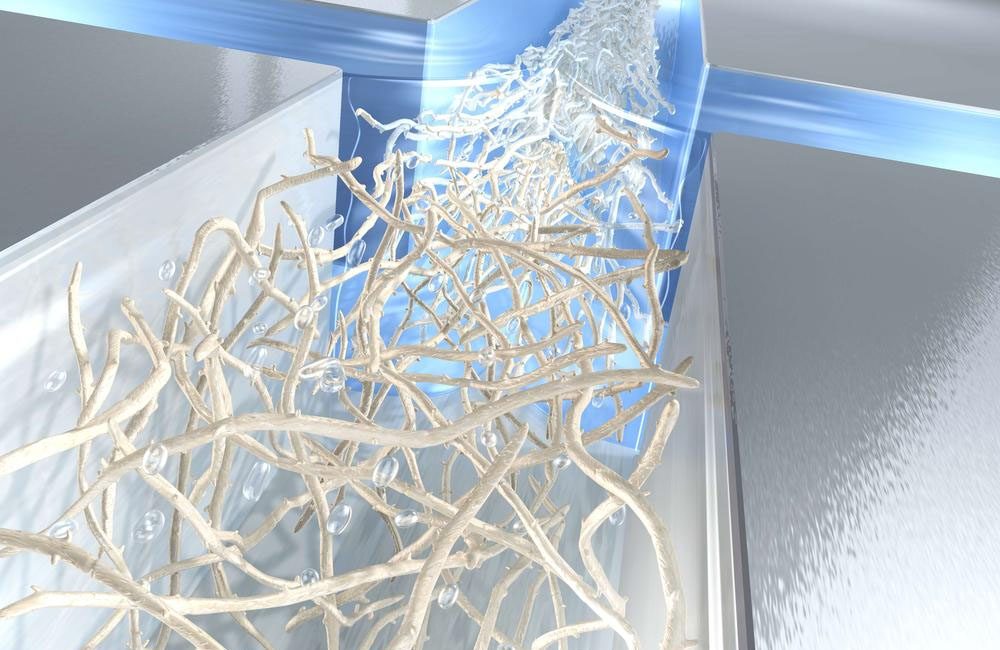| Mar 26, 2022 |
|
(Nanowerk News) A team of scientists from the Royal Institute of Technology (KTH) in Stockholm and DESY has developed a so-called digital twin for X-ray experiments and used it to study the production process of novel biofibres.
|
|
The digital twin allows the experimental data to be interpreted much more fully, thereby improving the quality of the fibres produced. Until now, X-rays have been used to experimentally observe and analyse the way fibres are spun from cellulose nanofibrils (CNF). Using the digital twin, these two-dimensional observations can be converted into a three-dimensional model.
|
|
The team has now published the results of its research in the journal ACS Nano (“Nanofibril Alignment during Assembly Revealed by an X-ray Scattering-Based Digital Twin”).
|
 |
| Artist´s impression of fibrils in the flow channel (the size of the fibrils is exagerated). The central flow is focused by two side flows, which generate an advantageous nanostructure of the fibre. (Image: DESY, Eberhard Reimann)
|
|
Cellulose is a renewable resource that occurs in nature in a wide variety of different forms and is an important structural component of wood and other plants. As a result, nanofibres made of cellulose are also a promising candidate for creating renewable building and construction materials.
|
|
Tiny cellulose fibres can be joined together to form high-strength filaments, stronger than steel or silk, and can even be functionalised by means of additives, to produce electrical conductors for example. These filaments are formed by squeezing the nanofibres, dissolved in water, through a very thin channel. Further water enters the channel from the sides, squeezing the stream of nanofibres together and accelerating it.
|
|
This so-called hydrodynamic focussing makes the nanofibres line up in the desired orientation and form a closely packed filament by themselves. The nanofibres stick together without glue or any other ingredient.
|
|
The Swedish and German scientists used DESY’s high-performance X-ray source PETRA III to observe these fibres in real time and at a high resolution while they were being produced and were able to refine the production process and the quality. However, the research group found that where and how the cellulose fibrils stick together depends very much on the length of the fibrils, which varies from tens to hundreds of nanometres.
|
|
Whereas the experiments were able to determine the orientation of the nanofibres in the filament with great precision, the length of the fibres could not be fully resolved using the existing experimental techniques.
|
|
To solve this problem, the scientists have now created a digital twin of the process: a complex digital model that simulates the entire manufacturing and investigation process.
|
|
“We have been working on this digital twin for six years,” says Fredrik Lundell (Wallenberg Wood Science Center at KTH). “By simulating the flow in the channel and taking into account the distribution of fibril lengths, we can now predict in detail where and for which channel geometries the optimal orientation is achieved for a particularly strong fibre.”
|
|
This digital model was continuously improved with the help of the X-ray experiments carried out at the PETRA III beamline P03. At the same time, the scientists also obtained information from the model which allowed them to analyse the data from the scattering experiments in more detail.
|
|
The digital twin thus ultimately provides a tomographic description of the processes occurring in the fibre, which can then be studied using two-dimensional X-ray control experiments.
|
|
“The model is in perfect agreement with the actual measurements and gives us completely new insights into the nanofibre production process,” explains Daniel Söderberg from the department of Fibre and Polymer Technology at KTH. “If previous experimental observations gave us the notes for creating the fibres, then the digital twin allows us to hear the entire symphony.”
|
 |
| The foreground shows pumps used to drive the flow in the channel. In the background, the X-ray beam traverses the flow channel from the right. (Image: KTH, Tomas Rosén)
|
|
The digital twin reveals how longer and shorter fibrils align in the filament, providing the missing link for developing robust industrial manufacturing processes needed for the mass production of high-performance CNF filaments.
|
|
The 3D X-ray microscope PETRA IV, which DESY is currently planning, could provide further real-world insights into such processes. The resolution of PETRA IV will be about a hundred times better than that of PETRA III, so that researchers will also be able to take a closer look at the entire production process, as well as the properties of such materials, which are of huge commercial interest.
|
|
A consortium of researchers led by KTH Stockholm has therefore proposed setting up a beamline for imaging fluid processes at PETRA IV, together with a digital twin.
|
|
DESY’s Stephan Roth, who is in charge of the PETRA beamline P03 and is also helping to plan the corresponding beamline for PETRA IV, says: “The digital twin developed here is of immense importance for process technology in connection with high-speed investigations using synchrotron radiation – especially for modern spinning techniques and, in the future, also for industrial coating technologies of the kind we are planning at PETRA IV.”
|




